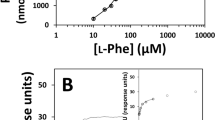Abstract
We have used a cell-free system derived from hamster brain to investigate protein synthesis during experimental phenylketonuria. In such a system the elongation inhibitor emetine impeded translation in extracts derived from both treated and control animals. On the other hand the initiation inhibitor aurintricarboxylic acid showed no effects on protein synthesis activity of treated hamsters, although it was severely inhibiting in controls. This suggests that initiation is the altered step in brain protein synthesis failure consecutive to phenylketonuria.
Similar content being viewed by others
Abbreviations
- ATA:
-
aurintricarboxylic acid
- HPA:
-
hyperphenylalaninaemia (hyperphenylalaninaemic)
- PHE:
-
phenylalanine
- PKU:
-
phenylketonuria (phenylketonuric)
- PR:
-
polyribosome
References
Hughes, J. V., and Johnson, T. C. 1978. Abnormal amino acid metabolism and brain protein synthesis during neural development. Neurochem. Res. 3:381–399.
Menkes, J. H. 1968. Cerebral proteolipids in phenylketonuria. Neurology 18:1003–1008.
Shaw, S. N., Peterson, N. A., and McKean, C. M. 1972. Impaired myelin formation in experimental hyperphenylalaninaemia. J. Neurochem. 19:479–485.
Aoki, K., and Siegel, F. L. 1970. Hyperphenylalaninaemia. Disaggregation of brain polyribosomes in young rats. Science 168:129–130.
Taub, F., and Johnson, T. C. 1975. The mechanism of polyribosome disaggregation in brain tissue by phenylalanine. Biochem. J. 151:173–180.
Roberts, S., and Morelos, B. S. 1976. Role of ribonuclease action in phenylalanine-induced disaggregation of rat cerebral polyribosomes. J. Neurochem. 26:387–400.
Agrawal, H. C., Bone, A. H., and Davison, A. N. 1970. Effect of phenylalanine on protein synthesis in the developing rat brain. Biochem. J. 117:325–331.
Lindroos, O. F. C., and Oja, S. S. 1971. Hyperphenylalaninaemia and the exchange of tyrosine in adult rat brain. Exptl. Brain Res. 14:48–60.
Hughes, J. V., and Johnson, T. C. 1976. The effects of phenylalanine on amino acid metabolism and protein synthesis in brain cellsin vitro. J. Neurochem. 26:1105–111.
McKean, C. M., Boggs, D. E., and Peterson, N. A. 1968. The influence of high phenylalanine and tyrosine on the concentrations of essential amino acids in brain. J. Neurochem. 15:235–241.
Antonas, K. N., and Coulson, W. F. 1975. Brain uptake and protein incorporation of amino acids studied in rats subjected to prolonged hyperphenylalaninaemia. J. Neurochem. 25:309–314.
Vahvelainen, M. L., and Oja, S. S. 1975. Kinetic analysis of phenylalanine-induced inhibition of the saturable influx of tyrosine, tryptophan, leucine and histidine into brain cortex slices from adult and 7-day-old rats. J. Neurochem. 24:885–892.
Hughes, J. V., and Johnson, T. C. 1977. The effects of hyperphenylalaninaemia on the concentration of aminoacyl-transfer ribonucleic acidin vivo: A mechanism for inhibition of neural protein synthesis by phenylalanine. J. Biochem. 162:527–537.
Hughes, J. V., and Johnson, T. C. 1978. Experimentally-induced and natural recovery from the effects of phenylalanine on brain protein synthesis. Biochim. Biophys Acta 517:473–485.
Siegel, F. L., Aoki, K., and Colwell, R. E. 1971. Polyribosome disaggregation and cell-free protein synthesis in preparations from cerebral cortex of HPA rats. J. Neurochem. 18:537–547.
Gauthier, D., and Murthy, M. R. V. 1988. Direct translation of brain polysomes in reticulocyte lysate. Med. Sci. Res. (in print).
Gauthier, D., and Murthy, M. R. V. 1987. Efficacy of RNase inhibitors during brain polysome isolation. Neurochem. Res. 12:335–339.
Cosgrove, J. W., Brown, I. R. 1981. Characterization of an initiating cell-free protein synthesis system derived from rabbit brain. J. Neurochem. 63:343–56.
Cosgrove, J. W., Rapoport, S. I. 1986. Preparation of a cell-free extract from rat brain which can initiate protein synthesisin vitro. Neurochem. Res. 11:1289–1301.
Jiménez, A., Carrasco, L., Vázquez, D. 1977. Enzymic and nonenzymic translocation by yeast polysomes. Sites of action of a number of inhibitors. Biochemistry 16:4727–4730.
Fresno, M., Carrasco, L., and Vázquez, D. 1976. Initiation of the polypeptide chain by reticulocyte cell-free systems. Survey of different inhibitors of translation. Eur. J. Biochem. 68:355–364.
Nowak, T. S., Carty, E. R., Lust, W. D., and Passonnean, J. V. 1984. Anin vitro amino acid incorporation for assessing the status ofin vivo protein synthesis. Anal. Biochem. 136:285–292.
Mackie, C. M., Buxton, D. B., and Mowbray, J. 1982. Aurintricarboxylic acid as both a stimulator and an inhibitor of cell-free protein synthesis by rat heart polyribosomes. Biochem. Biophys. Res. Comm. 104:750–757.
Bergman, J. E., and Lodish, H. F. 1979. A kinetic model of protein synthesis. Application to hemoglobin synthesis and translational control. J. Biol. Chem. 254:11927–11937.
Fleming, S. W., and Brown, I. R. 1986. Characterization of a translational inhibitor isolated from rabbit brain following intravenous administration of d-lysergic acid diethylamide. J. Neurochem. 446:1436–1443.
Raffel, C., Stein, S., and Kaempfer, R. 1974. Role for heme in mammalian protein synthesis: activation of an initiation factor. Proc. Natl. Acad. Sci. USA 71:4020–4024.
De Benedetti, A., Baglioni, C. 1986. Activation of hemin-regulated initiation factor-2 kinase in heat-shocked HeLa cells. J. Biol. Chem. 261:338–342.
Author information
Authors and Affiliations
Rights and permissions
About this article
Cite this article
Elsliger, MA., Thériault, G.R. & Gauthier, D. In vitro localization of the protein synthesis defect associated with experimental phenylketonuria. Neurochem Res 14, 81–84 (1989). https://doi.org/10.1007/BF00969762
Accepted:
Issue Date:
DOI: https://doi.org/10.1007/BF00969762




